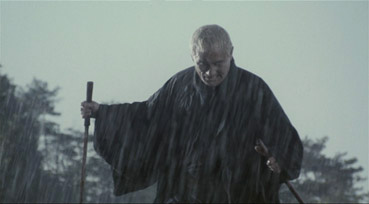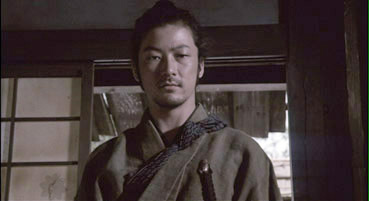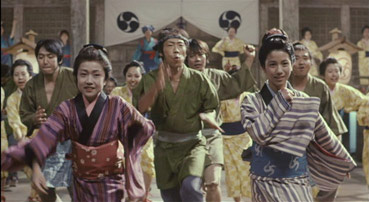|
Zatoichi, the latest film from director
Kitano Takeshi and his most commercially successful to date on home
turf, is always going to play differently to a western audience than a Japanese one. The original Zatoichi films are as much part of Japanese culture as Bond films are to ours, and
the best are every bit as highly regarded (with good reason, I should add), whereas in the UK these films remain largely unseen and to many unknown. Thus
a Japanese audience is inevitably going to approach this
new film as a remake of fondly regarded works from years past,
whereas a sizeable majority of the potential UK audience will be coming at it relatively fresh.
For them its most commercially significant element is its director/star, whose track record includes the electrifying Yakuza
films Boiling Point and Sonatine,
the humanist dramas with a comic edge A Scene
at the Sea and Kikujiro, the extraordinary
combination of violence, comedy and tenderness that was Hana-Bi, and the bold and compellingly
experimental Dolls,
films that have built him a solid fan base and made him one of the most
consistently compelling film-makers working today.
For the uninitiated, a little plot. Blind
masseur and skilled swordsman Zatoichi wanders the countryside, helping those in need of assistance,
gambling at every opportunity and doing battle with anyone
who attempts to assault him. By chance he falls in with the kind-hearted
O-Ume and her hapless nephew Shinkichi, and through him
encounters geishas O-Kinu and O-Sei, who have returned to
the town to seek revenge for the murder of their family
ten years earlier at the hands of a ruthless Ginzo gang.
Also in town is skilled ronin Hattori, who has agreed to serve as a bodyguard for the Ginzo boss for pay that will help his ailing
wife, putting
him in inevitable conflict with the two determined geishas
and their blind but deadly companion.

One of the first
first things that strikes you here about Takeshi the director
is how evenly he distributes the on-screen time of his characters – were it not for the fact that Zatoichi is the title of the film, you would often be pushed to regard
him as the central figure (the opening and closing
shots belong to him alone, though). But this is not the story of
just one man, and plays more as an ensemble piece in
which Zatoichi is a key player rather than the lead. His gambling scenes aside,
he tends to hover in the background and let the other stories
play out until the need for confrontation and action catapults
him to centre stage.
There's also a clear shift in Kitano's handling
of action. Violence has been a key element of many of the
director's previous films and he has often been direct
about its presentation, evident in the physical assaults in Boiling
Point, the stand-up bar-room gunfight in Sonatine and any number of shoot-outs in Brother. There has always been an unfussy brutality to these scenes,
which display little of the choreographed quality of Sam Peckinpah
or Hong Kong action cinema, instead having an almost observational
feel. Increasingly, though, Takeshi has balanced this
with what has become a signature use of editing, with the violence itself is not shown at all, bypassed when the build-up cuts straight to the consequences. Then again, the violence in question is sometimes horrible enough
to warrant this approach – the
chopsticks that are stabbed into a Yakuza's eye in Hana-Bi and slammed up the noses of a rival gang member in Brother do not need to be seen to send shudders down your back.
More often Takeshi uses this trick for comic effect, as in the
burning of the teacher's new car and the confrontation with
the big guy at the boxing hall in Kids Return,
and the hilarious near drowning at the hotel swimming pool
in Kikujiro. Its comic use is still here, as when Zatoichi tosses a log and knocks out the samurai wannabe
who spends his days charging around the outside of the house, but the violence, when it comes, is explicit, brutal, and shot and edited
with sometimes electrifying energy and economy. This
is not Hong Kong action cinema of the sort lifted by Tarantino
et al, but Japanese action cinema in the classic style,
where fights can be settled not with extended swordplay
and leaping around, but with a single, perfectly
judged blow. Thus those expecting a big climactic battle
may be in for a surprise, but for anyone who knows their
Japanese cinema it will prompt a fond twinge of recognition,
irresistibly recalling the climactic stand-off in Kurosawa's Sanjuro. Indeed, a Kurosawa influence can
be felt throughout the film, with settings, story elements,
a rain-drenched sword fight and a comic training sequence
echoing Seven Samurai, and the band of
outsiders that Zatoichi finds himself part of has the
same flavour as the rag-tag group of adventurers in The
Hidden Fortress, complete, of course, with its master
swordsman. It is to Kitano's credit that these elements never feel
poached, unlike any number of recent
American martial-arts influenced works.

While the blood-letting may not be new for Japanese action cinema or Kitano's own work, his decision to take his first steps down the CGI route are only partially successful. While the new technology does add
a dimensional physicality to the fights – swords thrust
backwards burst out through the bodies of their victims,
and in one memorably wince-inducing moment cut down the
shaft of an opponent's weapon and slice off part of his
hand – what surprises is that some of the
effects here aren't that convincing. Early on a
sword bursts out of the back of a would-be assailant and
pauses just long enough for you to see the wobble that indicates
an effect not completely matched with the action it
has been motion tracked to. But this is the curse of action-based
CGI – if not done perfectly, it looks a little false, but
even when convincingly executed the often ludicrous
nature of the action being depicted still brands it as fake,
just glossily so.
But
if the CGI sometimes fails to fully convince, this is a
very small fly in an otherwise rather gorgeous ointment. Zatoichi still very much bears the director's distinctive stamp,
especially in the prominence of the characters and their history and motivation within the framework
of the story. In
particular, the vengeful sister and her geisha-dressed brother
have a compellingly handled back story, one that a Japanese friend assures me is partly based on a factual
and well-documented case. Even Hattori, the supposed villain
of the piece, is sympathetically presented, a ronin fighting
not out of greed or malice but to procure funds for medical care for his ailing wife. Kitano also builds a degree of layering through the
introduction of a character who acts as a bad guy within
Hattori's own story, blurring the concept of hero and villain
so beloved of western cinema.
Kitano
delights in offbeat background characters and fully rounded
and engaging lead players, and the film is well served by
an excellent cast. As Zatoichi,
the enigmatic director/actor manages to avoid the intimidating
ghost of Katsu Shintaro and make the role pretty much his own. His closed-eyed
twitchiness and shuffling walk may make for an unlikely-looking
action hero, but when he does spring into action it's something
to see, and his movements are as precise and athletic as
a man half his age. As his eventual opponent Hattori, Asano Tadanobu
(who appeared previously with Takeshi in Oshima's Gohatto)
cuts an imposing figure and is utterly believable as the
driven and dangerously skillful ronin. As the two geishas
O-Kinu and O-Sei, Daike Yuuko and Tachibana Daigoro bring
an emotional gravitas to well written and intriguing characters,
and as the motherly O-Ume, Michiyo Ookuso displays a no-nonsense
strength of character that shines in her strong features, confident body language and line delivery.
Being
a Kitano film, as well as a Zatoichi one, the violence is
tempered by moments of sometimes broad character humour:
the training sequence in which the film's
hapless comic foil Shinkichi attempts to instruct a group of
dopey locals in the art of combat, only to be repeatedly
hit on the head; O-Ume's amused reaction to Zatoichi's
made-up fake eyes; the ambitious pair who want to try their
new sword on a passing blind man (guess who) and suffer
the consequences; the warrior who, in his enthusiasm to
attack Zatoichi, draws his sword with such gusto he cuts
his friend's arm.

None of which prepares you for the finale,
a musical tap-dance number choreographed by the dance group
The Stripes. It's a very real gamble on Takeshi's part, but astonishingly
it works a treat, in no small part due to the lively skill
of the dancers, the intoxicating rhythm of the music, and
the scene's thundering exuberance. Its arrival is
actually telegraphed by two earlier glimpses of four peasants
in a rice field (played by the dancers), first rhythmically
working the crops then dancing like lunatics; later they are seen
building a stage for the festival with tools that hammer,
saw and scrape out a beat, their music matched by Kitano's
tuneful camera placement and editing. Indeed, it was apparently
the need to match a musical score to these already set rhythms
that saw Takeshi for the first time break with long-time
music collaborator Joe Hisaishi in favour of Suzuki Keiichi,
who provides a splendid score throughout, but really comes
into his own in the final scene.
Zatoichi looks great on a first viewing, but four screenings later
I was in love with the film. With the rise of younger Japanese
directors such as Nakata Hideo, Miike Takashi and Kurosawa Kiyoshi, Takeshi still manages to make films that are so
distinctive, so inventive, so beautifully developed and
realised, that despite his potential old man status,
he remains as fresh a talent as the day he first turned
to cinema as a medium of artistic expression. Zatoichi is probably his most commercially minded feature yet, and
in some ways his most accessible for western audiences,
but that should not be taken as a criticism. With Zatoichi,
Takeshi has found possibly the ideal way to blend the historical,
the traditional, the populist and the artistic elements
of Japanese cinema in a single, really rather wonderful
package.
Framed
at 1.78:1 and anamorphically enhanced for widescreen TVs,
this is on the whole a very pleasing transfer, boasting a
good level of sharpness and detail and no visible dirt or
dust marks. There is some grain evident in some interior scenes,
but this is never distracting. Black levels are solid throughout.
Kitano uses a reduced colour palette for many scenes, the
opening having a muted, earthy look and the night scenes displaying
a bluish hue. Thus the colours tend to look less than vibrant
than on many modern films, but this is deliberate, and the
costumes of the finale are bright without looking over saturated.
A good print, well transferred to disk.
There
are two subtitle options available, Japanese and English,
the latter being well translated and containing no obvious
grammatical or spelling errors.
There
are two options here, Dolby 2.0 and Dolby 5.1, both in the
original Japanese. Though most of the dialogue is front and
centre, the music and some of the atmospheric sounds are spread far wider, and here the difference between the two tracks
is quite dramatic. One scene where this is most effectively
demonstrated sees Shinkichi borrow a beaten-up umbrella to
go for a walk in the rain – on the stereo track the rainfall
and score sit sedately at the front, but on the 5.1 track
they are louder, clearer (you can genuinely hear water sounds
that are just not audible on the stereo track) and come from
every direction, filling the room with falling rain. The final
musical number is especially impressive in 5.1, the music,
drum beats, tap-dancing, clapping and chanting reproduced
with wonderful fidelity and clarity, the subwoofer making
its presence discreetly but effectively felt. This contributes
in no small way to this scene's very real energy and sense
of fun.
Simple
though it is, the main menu is very nicely done, with Zatoichi's
name written across the screen in kanji, complete with a sound
effect that follows the writing across the front sound stage.
It settles down to perhaps the most famous publicity still
of the film (and the cover of the DVD), set against an animated
background and accompanied by a crash of thunder and an ominous
electronic rumbling. However, once you are here there is very
little on offer on this particular disk. All the options,
as you'd expect, are in Japanese.
The
chapter menu does contain clips from the film, which
I always think looks a little classy. Below this you can select
the sound and subtitle options, but this can also be altered
while the film is playing.
Finally
there is a trailer menu. The cinema trailer is in fine shape,
is framed 1.78:1 and anamorphically advanced, with a Dolby
2.0. It runs for 1 minute 24 seconds. A second trailer runs
for just under a minute, is similarly framed but non-anamorphic.
Also included are two 1.78:1, non-anamorphic TV spots, one
15 seconds, the other 30 seconds.
With
a renewed cinematic interest in all things Japanese being
demonstrated by western cinema, Zatoichi's
arrival on these shores is a timely one. Lost in Translation is all very well, but it's still ultimately an American tale
told through American eyes with American characters, a somewhat 'safe' viewing experience
for the unadventurous viewer weaned on western cinema. But
audiences and popular critical response do seem to be changing.
The sheer wonder and imagination of Spirited Away has effectively kicked both Disney and the recently departed
Pixar in the creative balls, and after the tiresome Hollywoodisation
of Japanese warrior codes and combat that was The
Last Samurai, Zatoichi arrives widely
hailed as the real deal. Although made by and for the Japanese,
the very lack of the messy excesses of Tarantino and the weary
posturing of a sumurai-dressed Tom Cruise may see the film find real favour
with a discerning international audience. Zatoichi is less an actioner than an effectively low key character
drama, spiced with bursts of superbly choreographed violence,
wittily handled comedy and a thumping good musical finale.
It not only rewards repeated viewings, but demands them.
At
the time of writing Zatoichi seems to be
getting a wider distribution than any previous Kitano-directed
film, but outside of cities and independent cinemas it can
still be hard to track down. If you can't get to see it in
the cinema, or you want to see it again and you cannot wait
to see what English DVD distributors do with it, then at present there are three DVDs of the film available. This
movie-only Japanese release has recently been followed by
a two-disk special edition, which boasts a substantial collection
of interviews and making-of featurettes on disk 2, though
none of these are subtitled. Both of these disks are region
2, so providing your TV can handle the NTSC signal they will
be playable on any UK DVD player. A similar, two disk special
edition is available on region 3.
The Japanese convention of surname first has been used throughout this review.
|